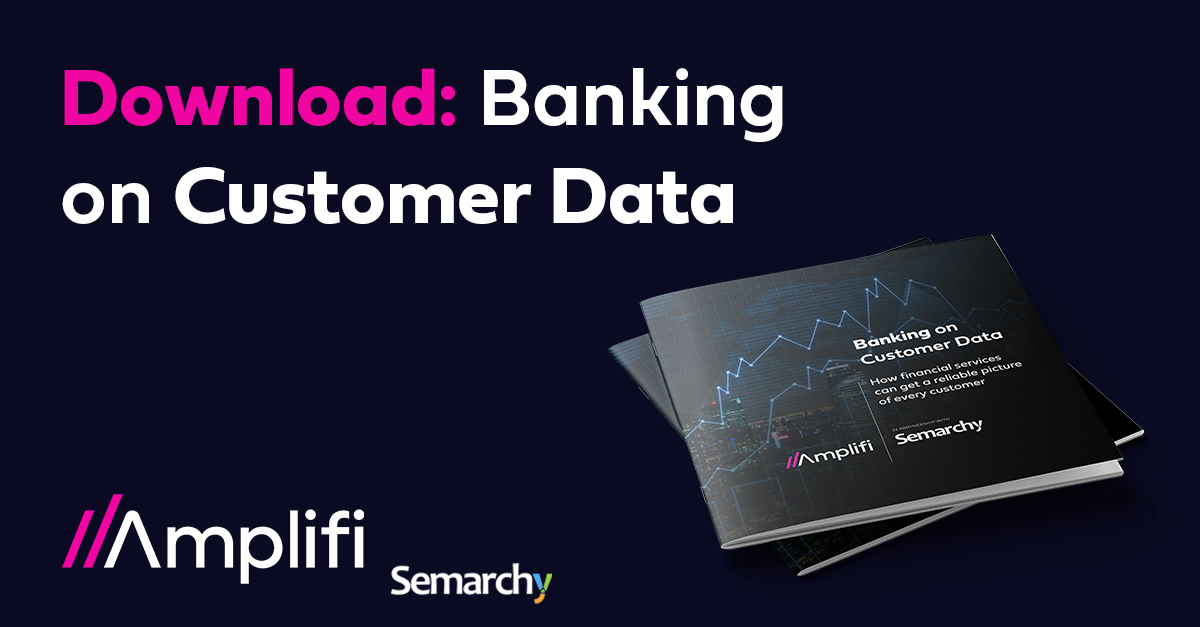Amplifi explores how effective customer master data management can help established mid-tier banks challenge the digital competition.
Banking, to state the obvious, has changed. Yet while digitization has transformed the way that financial services are delivered, what hasn’t changed fundamentally is what people really want from their banks.
The days of the local bank branch, with a bank manager that you know and trust, offering advice and products that are bespoke to you, might be long gone for most, but demand for the core principals behind that relationship has not. People still want convenience, trust, authenticity, personalization, and flexibility. They just want it in a different package in the digital age.
 Instead of a local branch, people want the convenience of banking on the go, to fit with their hectic schedules: an estimated 89% of US banking customers use online banking in 2022, with the number of millennials being around 97%. Instead of a personal relationship with a representative, they want trust in the brand they bank with. As for products, they want offers that are bespoke to their circumstances – the same as they always have.
Instead of a local branch, people want the convenience of banking on the go, to fit with their hectic schedules: an estimated 89% of US banking customers use online banking in 2022, with the number of millennials being around 97%. Instead of a personal relationship with a representative, they want trust in the brand they bank with. As for products, they want offers that are bespoke to their circumstances – the same as they always have.
It’s for these reasons that digital banks are experiencing such dramatic growth. By using data to react fast, adapt their offering, and customize their communications, they’re able to quickly and effectively offer their clients what they want from their financial services providers. To illustrate the rate of this growth, between 2022-2023:
- Bank of America increased its revenue from $053 billion to $130.968 billion.
- S. Bancorp saw a revenue increase from $27.401 billion to $31.058 billion.
- Citigroup went from $71.9. billion to $75.3 billion growth in revenue.
Yet while these banks are accelerating fast, it’s important not to lose context. US Bank, Citigroup, and Bank of America have 38 million, 20 million, and 118 million customers respectively in 2021 While established banks have the majority, it’s clear demand is steadily growing for a new type of banking experience – over a quarter of the US has an online-only bank account in 2023, with about 60% of consumers very or somewhat interested in using a digital bank in the next year – and digital banks are fast encroaching on mid-tier customer volumes.
In a world where customers demand to be able to open a new bank account, apply for a mortgage or switch their provider instantly, traditional banks need to adapt to the new normal, or else they might find themselves on the ropes. But to do this, they need to solve their data challenges, whether that’s fragmented customer data across different business units or inaccurate data in legacy systems. These new online-only banks benefit from being digital natives, free from the legacy data and technology baggage of more established institutions. If they want to catch up with digital innovation, banks need to tackle their ingrained data challenges.
An integrated data strategy – one based on consolidating customer data into a single source of truth – can help banks re-evaluate their data estate, helping them to target customers with personalized options, faster services, and an all-around better banking experience. But how?
DING DING DING! Let’s get ready for a royal data rumble.
Round 1: Data siloes VS a 360-degree view of your customers
Banks often have disparate data touchpoints feeding into their company, meaning data is segregated into siloes that aren’t connected to one another.
For example, mortgage handlers may have access to property values, while wealth managers can see a customer’s net worth – but there’s no integrated source of data to join them together. This could mean you could end up pitching offers and special rates to customers that just aren’t relevant (a customer with a high-value property, for example, isn’t interested in offers or accounts suited to first-time buyers) but how can you target consumers effectively without having a full picture of that consumer through their data?
This siloing of data could be down to any number of reasons. It could be because banks want to protect customer privacy and avoid hefty fines for breaking the rules. It might be because they have legacy systems that trillions of dollars pass through every day, making every change a pretty significant (not to mention high-risk) feat. Or it could be down to poor data governance and a lack of a single, central repository for their data.
The more disparate the data sources, the harder it is to get a 360-degree view of the customer. This makes it more difficult for banks to connect with their customers. After all, once someone’s received a ‘personalized’ mortgage offer for the fifth time with no intention of buying, you wouldn’t blame them for thinking their bank might not be right for them.
 If instead of storing data in siloes, banks can combine this data to get a comprehensive view of each individual customer (e.g. their age, their lifestyle, their interests, and the stage they are at in life), they’ll be in a much better position to offer personalized services, nurture customer relations and build trust. It’ll not only allow more established banks to compete more effectively with new challenger banks, but explore innovative and exclusive services that younger banks can’t offer.
If instead of storing data in siloes, banks can combine this data to get a comprehensive view of each individual customer (e.g. their age, their lifestyle, their interests, and the stage they are at in life), they’ll be in a much better position to offer personalized services, nurture customer relations and build trust. It’ll not only allow more established banks to compete more effectively with new challenger banks, but explore innovative and exclusive services that younger banks can’t offer.
End of Round 1: A win for a centralized, single source of data.
Round 2: Run-of-the-mill banking VS a memorable customer experience
Banks need to find ways to retain their customers so that they don’t flock to glossy, new contenders – but to do this they need to find ways to appeal to customers ready to make the jump. The only way to do that is to have a strong, clear view of customer data that facilitates deeper analysis and targeted marketing.
Banks need to use data to segment their customers and offer them the best possible products and services to match their personal experiences. If a customer feels like their wants and needs are being catered to, they’ll be much less inclined to jump ship to a challenger bank.
End of Round 2: Banks can win by using data to find their customers’ weaknesses.
Round 3: Going it Alone VS a data governance solution you can trust
According to a Gartner report, 80% of heritage financial services firms could struggle to remain relevant by 2030 as digital platforms, FinTechs, and non-traditional challengers gain greater market share.
If traditional retail banks want to survive, they need to get a handle on their data so that they can nurture customer relationships, retain loyal customers and attract new ones. And in this respect, Amplifi is well-placed to tip the odds in your favor.
Amplifi’s master data management financial solution cleans, validates, and integrates your data to create one seamless point of reference for all your critical information. We help banks to take control and leverage their data, ensuring it is harmonized across departments, instead of divvied up into silos.
So, if disparate data sources and expensive legacy tech is making you think about throwing in the towel, get in touch today. Amplifi will get you match-ready with a single, authoritative view of business-critical data across your organization, providing insightful, actionable, and clean data.
Don’t head into the coming bout with your customer data without a seasoned trainer at your side. From MDM to data governance, quality, and migration solutions, Amplifi has extensive expertise you can rely on. Get in touch by calling +1-855-321-8500 or head to our contact page.


